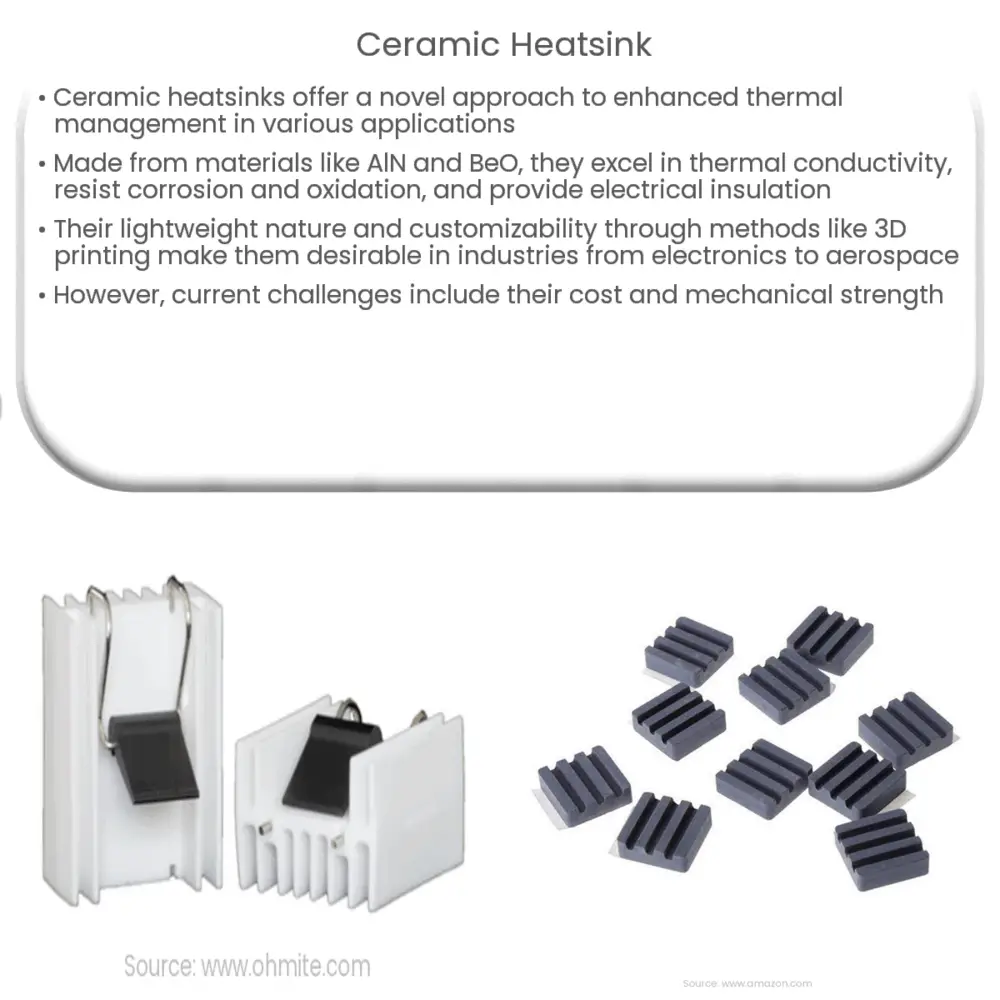Ceramic heatsinks efficiently dissipate heat in electronics, offering high thermal conductivity, corrosion resistance, electrical insulation, and lightweight properties.

Ceramic Heatsinks: An Innovative Solution for Enhanced Thermal Management
Introduction
In recent years, the demand for efficient and reliable cooling solutions in electronics and other heat-generating devices has increased significantly. Traditional metallic heatsinks, although effective, have certain limitations that can hinder optimal performance. Ceramic heatsinks have emerged as an innovative alternative to overcome these challenges. This article delves into the science behind ceramic heatsinks, their advantages over metallic counterparts, and the potential applications of this advanced thermal management technology.
Understanding Ceramic Heatsinks
A ceramic heatsink is a type of thermal management device made from ceramic materials, typically aluminum nitride (AlN) or beryllium oxide (BeO). These materials are known for their high thermal conductivity, low thermal expansion, and excellent electrical insulation properties. Ceramic heatsinks are designed to efficiently dissipate heat generated by electronic components and maintain their operational temperature within a safe range.
One key advantage of ceramic heatsinks over traditional metallic heatsinks, such as those made from aluminum or copper, is their superior thermal performance in certain applications. While metals like copper have higher thermal conductivity, they can be affected by issues like corrosion and oxidation, which can lead to reduced efficiency over time. Ceramic heatsinks, on the other hand, offer excellent resistance to corrosion and oxidation, ensuring consistent thermal performance even in harsh environments.
Benefits of Ceramic Heatsinks
There are several benefits to using ceramic heatsinks in various applications:
- High thermal conductivity: Ceramic heatsinks made from materials like AlN and BeO offer thermal conductivity values close to those of metals like aluminum and copper, making them suitable for efficiently transferring heat away from critical components.
- Resistance to corrosion and oxidation: Unlike metallic heatsinks, ceramic heatsinks are not susceptible to corrosion and oxidation, ensuring consistent and reliable thermal performance over time.
- Electrical insulation: Ceramic materials exhibit excellent electrical insulation properties, reducing the risk of electrical shorts and enhancing safety in high-voltage applications.
- Lightweight: Ceramic heatsinks are generally lighter than their metallic counterparts, making them ideal for weight-sensitive applications such as aerospace and portable electronics.
- Customizability: Advanced manufacturing techniques like 3D printing enable the fabrication of complex ceramic heatsink structures tailored to specific thermal management requirements.
Applications of Ceramic Heatsinks
Due to their unique properties, ceramic heatsinks have found applications across a wide range of industries:
- Electronics: High-power electronic components, such as transistors, integrated circuits, and LEDs, benefit from the excellent thermal management capabilities of ceramic heatsinks.
- Automotive: Electric and hybrid vehicles require efficient cooling solutions for their power electronics and battery systems. Ceramic heatsinks can offer effective thermal management while minimizing weight and space constraints.
- Aerospace: The lightweight and corrosion-resistant properties of ceramic heatsinks make them suitable for use in satellites, spacecraft, and other aerospace applications where weight and reliability are critical factors.
Telecommunications:
High-power radio frequency (RF) components and systems used in telecommunications infrastructure, such as base stations and antennas, can benefit from ceramic heatsinks’ thermal conductivity and electrical insulation properties, ensuring optimal performance and reliability.
Medical Equipment:
Medical devices like MRI machines, X-ray equipment, and surgical lasers require efficient cooling solutions to maintain safe operating temperatures. Ceramic heatsinks can provide effective thermal management while minimizing the risk of electrical interference with sensitive components.
Renewable Energy:
Power electronics used in solar inverters, wind turbine generators, and other renewable energy applications require reliable and efficient cooling solutions. Ceramic heatsinks can help ensure consistent performance and extend the lifespan of these critical components.
Challenges and Future Developments
Despite their many advantages, ceramic heatsinks also face some challenges that must be addressed to expand their adoption:
- Cost: Ceramic materials like AlN and BeO can be more expensive than traditional metals like aluminum and copper, which can be a limiting factor in their widespread use. However, ongoing research and technological advancements are expected to lower production costs over time.
- Mechanical strength: While ceramic materials exhibit excellent thermal and electrical properties, their mechanical strength and brittleness can be a concern in certain applications. Researchers are actively working on developing new ceramic materials and composites to overcome these limitations.
As technology continues to evolve, the demand for efficient thermal management solutions will only grow. Ceramic heatsinks offer a promising alternative to traditional metallic heatsinks, and ongoing research and development efforts are expected to further enhance their performance and lower their cost. As a result, ceramic heatsinks are poised to become an increasingly important component in a wide range of industries, helping to ensure the reliable and efficient operation of electronic devices, vehicles, medical equipment, and more.
Conclusion
Ceramic heatsinks provide an innovative and effective solution for thermal management in various applications. Their high thermal conductivity, resistance to corrosion and oxidation, electrical insulation properties, and lightweight nature make them an attractive alternative to traditional metallic heatsinks. With continued advancements in materials science and manufacturing technologies, ceramic heatsinks are expected to play an increasingly significant role in industries such as electronics, automotive, aerospace, telecommunications, medical equipment, and renewable energy, among others. As the demand for efficient thermal management continues to rise, ceramic heatsinks have the potential to revolutionize the way heat is managed in a wide range of applications, ensuring optimal performance and reliability.

